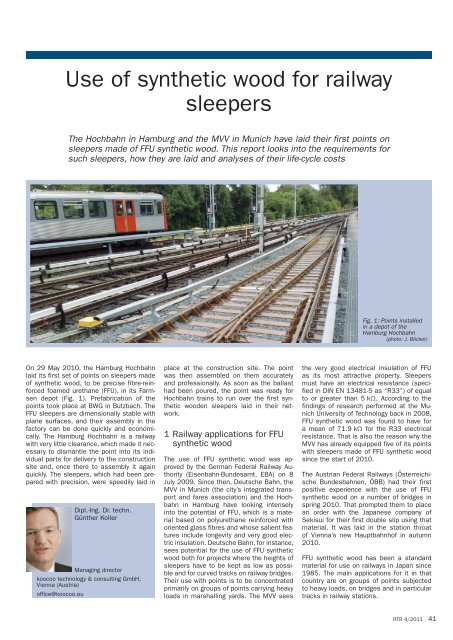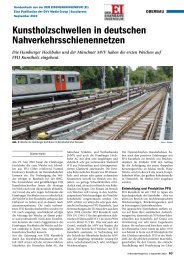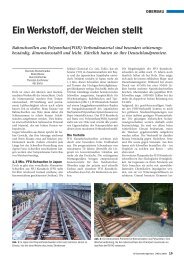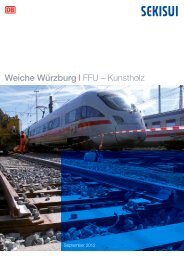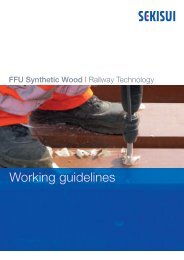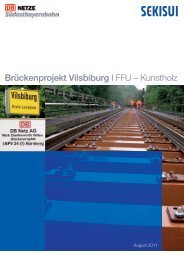European Rail Technology Review | April 2011
European Rail Technology Review | April 2011
European Rail Technology Review | April 2011
You also want an ePaper? Increase the reach of your titles
YUMPU automatically turns print PDFs into web optimized ePapers that Google loves.
Use of synthetic wood for railway<br />
sleepers<br />
The Hochbahn in Hamburg and the MVV in Munich have laid their first points on<br />
sleepers made of FFU synthetic wood. This report looks into the requirements for<br />
such sleepers, how they are laid and analyses of their life-cycle costs<br />
Fig. 1: Points installed<br />
in a depot of the<br />
Hamburg Hochbahn<br />
(photo: J. Böcker)<br />
On 29 May 2010, the Hamburg Hochbahn<br />
laid its first set of points on sleepers made<br />
of synthetic wood, to be precise fibre-reinforced<br />
foamed urethane (FFU), in its Farmsen<br />
depot (Fig. 1). Prefabrication of the<br />
points took place at BWG in Butzbach. The<br />
FFU sleepers are dimensionally stable with<br />
plane surfaces, and their assembly in the<br />
factory can be done quickly and economically.<br />
The Hamburg Hochbahn is a railway<br />
with very little clearance, which made it necessary<br />
to dismantle the point into its individual<br />
parts for delivery to the construction<br />
site and, once there to assembly it again<br />
quickly. The sleepers, which had been prepared<br />
with precision, were speedily laid in<br />
Dipl.-Ing. Dr. techn.<br />
Günther Koller<br />
Managing director<br />
koocoo technology & consulting GmbH,<br />
Vienna (Austria)<br />
office@koocoo.eu<br />
place at the construction site. The point<br />
was then assembled on them accurately<br />
and professionally. As soon as the ballast<br />
had been poured, the point was ready for<br />
Hochbahn trains to run over the first synthetic<br />
wooden sleepers laid in their network.<br />
1 <strong>Rail</strong>way applications for FFU<br />
synthetic wood<br />
The use of FFU synthetic wood was approved<br />
by the German Federal <strong>Rail</strong>way Authority<br />
(Eisenbahn-Bundesamt, EBA) on 8<br />
July 2009. Since then, Deutsche Bahn, the<br />
MVV in Munich (the city’s integrated transport<br />
and fares association) and the Hochbahn<br />
in Hamburg have looking intensely<br />
into the potential of FFU, which is a material<br />
based on polyurethane reinforced with<br />
oriented glass fibres and whose salient features<br />
include longevity and very good electric<br />
insulation. Deutsche Bahn, for instance,<br />
sees potential for the use of FFU synthetic<br />
wood both for projects where the heights of<br />
sleepers have to be kept as low as possible<br />
and for curved tracks on railway bridges.<br />
Their use with points is to be concentrated<br />
primarily on groups of points carrying heavy<br />
loads in marshalling yards. The MVV sees<br />
the very good electrical insulation of FFU<br />
as its most attractive property. Sleepers<br />
must have an electrical resistance (specified<br />
in DIN EN 13481-5 as “R33”) of equal<br />
to or greater than 5 kΩ. According to the<br />
findings of research performed at the Munich<br />
University of <strong>Technology</strong> back in 2008,<br />
FFU synthetic wood was found to have for<br />
a mean of 71.9 kΩ for the R33 electrical<br />
resistance. That is also the reason why the<br />
MVV has already equipped five of its points<br />
with sleepers made of FFU synthetic wood<br />
since the start of 2010.<br />
The Austrian Federal <strong>Rail</strong>ways (Österreichische<br />
Bundesbahnen, ÖBB) had their first<br />
positive experience with the use of FFU<br />
synthetic wood on a number of bridges in<br />
spring 2010. That prompted them to place<br />
an order with the Japanese company of<br />
Sekisui for their first double slip using that<br />
material. It was laid in the station throat<br />
of Vienna’s new Hauptbahnhof in autumn<br />
2010.<br />
FFU synthetic wood has been a standard<br />
material for use on railways in Japan since<br />
1985. The main applications for it in that<br />
country are on groups of points subjected<br />
to heavy loads, on bridges and in particular<br />
tracks in railway stations.<br />
RTR 4/<strong>2011</strong> 41
• Use of synthetic wood for railway sleepers<br />
high volume of traffic carried and the short<br />
headways (Fig. 2).<br />
It was not until 2004 that the first use in<br />
Europe followed. That was near Zollamtsbrücke<br />
on the Vienna metro network. Its operator,<br />
Wiener Linien, found FFU synthetic<br />
wood to be the sort of high-grade material it<br />
was in search of for its superstructure and<br />
capable of satisfying its targets as regards<br />
maintenance intervals:<br />
replacement of rails > 30 years<br />
corrosion protection > 30 years<br />
replacement of bridge timbers<br />
> 50 years, and<br />
overhaul work on steel structures<br />
> 50 years<br />
Fig. 2: Points mounted on FFU synthetic wood on a slab track in Japan <br />
Fig. 3: Artificial bridge timbers for the<br />
Ostbahn Bridge of ÖBB in Vienna,<br />
with a cant as delivered from the factory<br />
<br />
(Source of Figs 3-7: the author)<br />
Prior to that, the Japanese railways had<br />
analysed their statistical records and had<br />
established that more than 70% of their<br />
railway sleepers made of natural wood had<br />
only a very short service life after laying on<br />
account of weathering. They started to look<br />
(source: Sekisui)<br />
Wiener Linien have been laying FFU sleepfor<br />
an alternative, and Sekisui developed<br />
this in 1978 in the form of FFU synthetic<br />
wood. FFU is a material that is similar to<br />
natural wood as regards its positive service<br />
properties in railway tracks as well as<br />
simplicity of handling and processing. Its<br />
specific mass is almost identical to that<br />
of natural wood, but its life expectancy is<br />
very considerably longer, and it is much<br />
tougher in its weathering resistance. The<br />
<strong>Rail</strong>way Technical Research Institute computed<br />
the service life to be more than fifty<br />
years on the basis of an extrapolation of<br />
100 000 000 load cycles applied to an FFU<br />
sleeper after it had been in daily use for<br />
15 years.<br />
Since 1985, more than 1000 km of track<br />
have been laid with FFU sleepers. Taking,<br />
for instance, the Shinkansen line between<br />
Tokyo and Osaka, all its points and steel<br />
bridges are equipped with such sleepers.<br />
Shinkansen trains, which have headways of<br />
between three and five minutes, operate on<br />
that line at speeds of up to 300 km/h. The<br />
private Japanese railway decided to use<br />
top-grade, long-lived materials, prompted<br />
by the need to assure excellent network<br />
availability and reliability of the track superstructure<br />
and also considering the very<br />
Fig. 4: Direct fastening<br />
with FFU sleepers with<br />
a height of 10 cm in<br />
Vienna<br />
Since 2005, the Austrian Federal <strong>Rail</strong>ways<br />
have also been using FFU synthetic wood,<br />
predominantly on open steel structures and<br />
on and near less important level crossings.<br />
In 2008, the first point equipped with FFU<br />
synthetic wooden sleepers was laid in Germany<br />
in the Chemiepark railway complex in<br />
Leverkusen.<br />
2 The material and its<br />
preparation in the factory<br />
The technology used for manufacturing<br />
FFU synthetic wood is pultrusion, subject<br />
to strict ISO-certified quality assurance.<br />
Continuous oriented glass-fibre strands are<br />
pulled through a roller-type extruder, cast in<br />
polyurethane and cured at an elevated temperature.<br />
The outcome is a very high grade,<br />
pore-free material.<br />
If so ordered by its customers, the factory is<br />
capable of producing, uniquely labelling and<br />
delivering bridge timbers and railway sleepers<br />
in synthetic wood as finished products,<br />
precisely shaped and with a dimensional<br />
accuracy in the millimetre range.<br />
The following jobs are performed on the FFU<br />
sleepers in the factory:<br />
removal of the belt reinforcement by milling<br />
milling work on longitudinal girders<br />
milling countersinks for rivet heads<br />
drilling holes for bolted connections<br />
surface sanding, and<br />
adding material to produce cants<br />
The Austrian Federal <strong>Rail</strong>ways made use of<br />
the possibilities just listed in 2009 in order<br />
to be able to implement the target gradient<br />
of bridge structures quickly and cheaply by<br />
using FFU timbers that had been prefabricated<br />
in the factory (Fig. 3). Every bridge<br />
timber had a different height and, by being<br />
able to compensate for the permanent deformation<br />
of the bridge, this method resulted<br />
in an optimum track position.<br />
42<br />
RTR 4/<strong>2011</strong>
Use of synthetic wood for railway sleepers •<br />
Fig. 5: Drilling countersinks for rivet heads (ÖBB, Hainburg)<br />
Fig. 6: Chiselling in the abutment zone of the bridge over the river Sava<br />
(Belgrade)<br />
ers on their network since 2007. The dimensions<br />
used are:<br />
width: 26 cm<br />
height: 10 cm, and<br />
lengths: 201 and 250 cm,<br />
The shorter sleepers have been laid on<br />
Floridsdorfer Bridge (Fig. 4), and the longer<br />
ones in tunnels, where there are mass-andspring<br />
systems.<br />
3 In-situ processing of the<br />
synthetic wooden sleepers<br />
situations. The critical price was determined<br />
for different wage levels, assuming<br />
that the load-bearing structure would have a<br />
residual service life of, firstly, more than 15<br />
years and, secondly, more than 30 years.<br />
This was done, since the input parameter<br />
had originally been set at 15 years to equal<br />
the mean practical service life of bridge timbers<br />
made of natural wood. The imputed<br />
rate of interest was forecast on the basis of<br />
the extremely long expected service life of<br />
FFU bridge timbers of more than 50 years<br />
and, after performing a sensitivity analysis,<br />
was then taken to be a real 3% higher than<br />
the rate of inflation.<br />
Having established this basis, it was then<br />
possible to calculate the critical prices of<br />
the FFU bridge timbers for various wage levels,<br />
which showed that their economic performance<br />
was better on the assumption of<br />
one replacement of conventional bridge timbers<br />
having been avoided (after 15 years)<br />
or two such replacements having been<br />
avoided (after 30 years). The price level of<br />
FFU synthetic wood taken for the purpose<br />
The drilling of holes for holding rail fastenings,<br />
the cutting of FFU synthetic wood,<br />
milling operations and chiselling are performed<br />
with standard tools in a similar way<br />
to natural wood (Figs. 5 and 6). Widia tools<br />
(these are made of very hard steel, nearly<br />
as hard as diamonds) are recommended for<br />
these jobs or, alternatively, ones designed<br />
for metal-working. Practice, however, shows<br />
that experienced contractors’ workers<br />
sometimes resort to simple power saws in<br />
a similar way to the processing of natural<br />
wood (Fig. 7). The drawback to using conventional<br />
timber saws, however, is that their<br />
chains are likely to wear down very quickly.<br />
Any rail fastenings recovered from the old<br />
wooden sleepers can be reused straightaway<br />
in the new FFU ones.<br />
4 Examination of life-cycle costs<br />
(LCCs) at Graz University of<br />
<strong>Technology</strong><br />
In 2008, Graz University of <strong>Technology</strong>, working<br />
on a contract from the Austrian Federal<br />
<strong>Rail</strong>ways, performed an LCC analysis of FFU<br />
bridge timbers on open steel bridges compared<br />
with the use of natural wood for this<br />
purpose [1]. It performed a similar analysis<br />
again in 2009, but varying a number of key<br />
input parameters. For instance, it reduced<br />
the specific labour requirement when using<br />
FFU sleepers in track curves by 20 %,<br />
thereby better reflecting their advantage<br />
over natural wooden ones in complicated<br />
RAILWAY TECHNOLOGY<br />
State of the Art<br />
FFU SYNTHETIC SLEEPER CALMMOON RAIL FLAT FFU SLEEPER<br />
SEKISUI CHEMICAL GmbH<br />
Cantadorstr.3<br />
D-40211 Düsseldorf<br />
TEL: +49-(0)211-36977-0<br />
FAX: +49-(0)211-36977-31<br />
E-Mail: ffu@sekisui.de<br />
www.sekisui-railwaytechnology.com<br />
RTR 4/<strong>2011</strong> 43
• Use of synthetic wood for railway sleepers<br />
Curve – 240 bridge timbers<br />
Wage level<br />
Imputed real interest rate = 3 % 110% 100 % 90 % 80 %<br />
First replacement rendered unnecessary +29 +21 +13 +5<br />
Second replacement rendered unnecessary +85 +73 +61 +49<br />
Table 1: Critical price of material for different wage levels (+ = profit, – = loss)<br />
FFU synthetic wooden sleepers are manufactured<br />
in accordance with precise specifications,<br />
and the products delivered deviate<br />
from the dimensions ordered by only a few<br />
millimetres’ manufacturing tolerance. FFU<br />
synthetic wood stably maintains its shape<br />
after positioning and lies flush on the<br />
flanges of steel beams, with nearly 100 %<br />
surface contact with them. Moreover, it retains<br />
its homogenous structure. Thanks to<br />
this stability of shape, sleepers made of<br />
synthetic wood can be quickly and immeof<br />
this calculation corresponds to the price<br />
that would be typically paid for an order for<br />
more than 20 m³. The wage level in Austria<br />
was taken to be 100 %. The results (Table 1)<br />
show that the use of FFU synthetic wood is<br />
more economical than conventional bridge<br />
timbers for the organisation responsible for<br />
maintaining the railway line. The savings<br />
are those values preceded by a plus sign.<br />
Professor Veit (of Graz University of <strong>Technology</strong>)<br />
summed up the outcome of the LCC<br />
analysis as follows:<br />
If a real value of 3 % is taken for an imputed<br />
rate of interest, it is possible to<br />
use FFU synthetic wood as a standard<br />
solution at Austrian wage levels,<br />
FFU bridge timbers demonstrate advantages<br />
in technically demanding limiting<br />
conditions, thanks to production flexibility,<br />
since, with these, it is to be expected<br />
that the specific labour requirement<br />
would be significantly less. This, in turn,<br />
would have a positive impact on the business<br />
case; and<br />
Fig. 7: Sawing work on<br />
the construction site on<br />
the bridge over the river<br />
Sava (Belgrade)<br />
FFU bridge timbers are a further step<br />
towards a sustainable track superstructure,<br />
a property which is going to become<br />
even more important, especially<br />
considering the increasing number of<br />
trains and, as a consequence of that,<br />
the reduced time available in future for<br />
doing maintenance work.<br />
5 Experience, advantages and<br />
benefits<br />
diately put into place on open steel structures.<br />
In track curves, FFU sleepers, which<br />
have been precisely prepared and clearly labelled<br />
in the factory, can be very quickly and<br />
professionally put into place. Their mass,<br />
which is close to that of natural wood (FFU<br />
74 = 740 kg/m³), ensures easy handling<br />
at the engineering site and offers static<br />
advantages, especially in combination with<br />
steel structures. The load-dissipating structure<br />
is clear, unequivocal and homogenous.<br />
The material has no pores in it and thus<br />
does not retain liquids. It does not contain<br />
any insecticides. It does not undergo any<br />
change on contact with greases and chemicals<br />
used on the railways. Its ingredients<br />
are simply polyurethane and continuous<br />
glass fibres.<br />
On ballasted railway tracks, the lower face<br />
of FFU sleepers grips the ballast in a similar<br />
way to natural wooden sleepers. Repair<br />
work is simple, conventional cutting and<br />
drilling tools can be used, and any skill<br />
acquired in working with natural wood can<br />
be put to use with synthetic wood too. The<br />
outlay on maintenance work (which is a<br />
key cost factor for railway operators) can<br />
be generally minimised, as has been demonstrated<br />
in practice, thanks to the good<br />
load dissipation, the good, long-term adhesion<br />
between sleeper screws and synthetic<br />
wood, excellent resistance to weathering<br />
and the permanently closed structure.<br />
On the basis of the LCC analysis performed<br />
in Graz, the initial capital outlay for creating<br />
the track superstructure on bridges using<br />
FFU synthetic wood is in the range of 1.35<br />
to 1.55 times what it would be if natural<br />
wood were to be used. The life expectancy<br />
of FFU, on the other hand, is three to five<br />
times that of the natural wood typically used<br />
for bridge timbers today. Should it happen<br />
that the FFU timbers need to be replaced<br />
after a period of more than 50 years, industrial<br />
methods of complete recycling are<br />
available for them.<br />
Reference<br />
[1] Life Cycle Cost Analysis, Graz University of <strong>Technology</strong>,<br />
a. o. Univ.-Prof. Peter Veit and Dr. Marschnig,<br />
2008<br />
¡Viva España!<br />
Use our country feature RTR Spain as your advertising platform!<br />
Strengthen your activities on the Spanish railway market.<br />
Book your advert for this issue by 14th May 2012.<br />
<br />
<br />
<br />
<br />
<br />
<br />
<br />
<br />
Revista Técnica de<br />
los Ferrocarriles<br />
<br />
<br />
<br />
<br />
<br />
<br />
<br />
<br />
Euro 16,50<br />
www.eurailpress.de/rtr<br />
ISSN 0079-9548<br />
I look forward to your reply.<br />
Tel: +49/40/237 14 - 171, E-mail: Silvia.Sander@dvvmedia.com<br />
<br />
44<br />
4437_anz_RTR_RTRSpain_182x64_en.indd 1 05.03.2012 10:48:11<br />
RTR 4/<strong>2011</strong>


